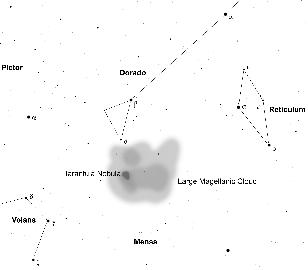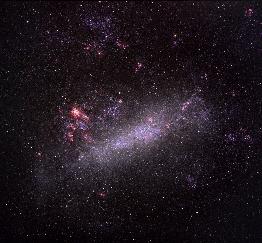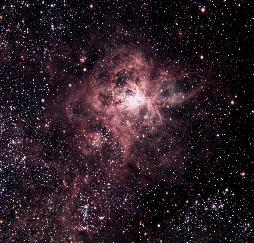Dorado
This constellation, close to the south celestial pole, is highest in the sky during the winter months. It lies south and a little west of the very bright southern star Canopus. Within its boundaries lies the Large Magellanic Cloud (LMC), an A-List object, whilst another lies within the LMC itself.
LMC - Large Magellanic Cloud Irregular Galaxy E B L
The LMC is an irregular (or possibly barred spiral) galaxy that, at about 170 -180 thousand light years distance, is the second closest galaxy to our own Milky Way. It is at least 50,000 light years in diameter and contains several billion stars. The LMC is the fourth largest galaxy in our local group of galaxies (dominated by the Milky Way, M31 and M33). To the unaided eye it appears just like a cloud seen against a dark sky, or a part of the milky way that has somehow got detached. It must have been known since humans first looked up at the southern sky but was "discovered" by the Portuguese explorer Ferdinand Magellan in 1519. The LMC has an angular diameter of 6 degrees and will thus nicely fill the field of view of most binoculars. A telescope using at low power will only be able to sweep across the galaxy picking up the many bright nebulae and open star clusters. The most spectacular of these merits is own entry into the A-List.
Position 5h 23.5m -69deg 45min
30 Doradus Open Star Cluster and Diffuse Nebula E B M
The name 30 Doradus is used collectively for a bright nebula, commonly called the Tarantula nebula due to its similarity in appearance to the spider of that name, and the cluster of star embedded within it. The collective name comes from the fact that together they were first catalogued as a star.
The Tarantula Nebula is an immense star forming region, vastly bigger than the Orion Nebula, where clouds of gas are being excited by the ultra-violet radiation emitted by the very hot young stars that have formed within it. In fact, were it as close as the Orion Nebula, it would cover an area of sky 30 degrees across! It is the most massive HII region, as these regions are called, in the local group of galaxies. Lying at a distance of about 165 - 170 thousand light years it is over 3000 light years in extent. (For comparison the Orion Nebula is 40 light years across.) It contains a vast number of blue supergiants, type-O stars that are amongst the most massive and luminous known - around 100 times the mass of the Sun and perhaps 100,000 times as luminous. Blue supergiant stars have short lives and evolve quickly ending their lives in spectacular supernova explosions. Astronomers were treated to just such an event in 1987; the resulting remnant, 1987A, having been studied extensively ever since. To the unaided eye the 30 Doradus region, about the angular size of the full moon, appears rather like the Lagoon Nebula, M8, in Sagittarius. Visually about 4th magnitude, it is best seen with binoculars and telescopes. The brightest stars within the cluster at its heart are between 14th and 12 magnitude so can be individually seen under dark skies and good seeing. Even the smallest telescopes will reveal the complex structure, showing loops of excited gas and embedded stars. With telescopes of 8 or more inches (>200mm) the visual appearance can even approach that seen in the wonderful photographs of the region.
Position: 5h 38.6m -69deg 05min






